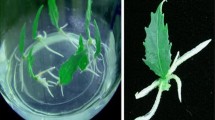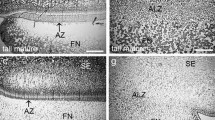Abstract
Localization of the 49-kDa apyrase (ATP diphosphohydrolase, EC3.6.1.5; DDBJ/EMBL/GenBank BAB40230) was investigated during early stages of germination of pea (Pisum sativum L. var. Alaska) at the organ, tissue, cellular, and sub-cellular level using light-microscopical immunohistochemistry. Whole mount tissues were immuno-reacted with anti-APY1 serum, pre-immune serum or anti-actin antibody for control. Antigen to the anti-APY1 serum was not detected until 16 h after sowing (26 h after start of imbibition), when the antigen was detected throughout the tissue, especially in the epidermis and cortex. At 35 h after sowing, the younger regions including the root tip and the tip of the stele were more strongly stained than the control. Both, epidermal and cortical cells of the epicotyl and root tip were stained. The stain was mainly localized in the cytoplasm and around nuclei in the apical meristem and the root tip, while vacuoles and cell walls were not stained. At 62 h, there was major staining in the plumule, hook, and elongating regions of the epicotyl and in the region between cotyledons and the epicotyl. After 84 h, lateral root primordia were stained. The pre-immune serum showed virtually no staining while the anti-actin antibody reacted solely with the cytoplasm. Since the antigen to the anti-APY1 serum was primarily found in the cytoplasm and around nuclei in elongating and differentiating tissues and labeling declined in mature tissues, it is suggested that apyrases may play a role in growth and development of tissues, for example, lateral roots.






Similar content being viewed by others
Abbreviations
- HS:
-
Hours after sowing
References
Abe S, Davies E (1991) Isolation of F-actin from pea stems—evidence from fluorescence microscopy. Protoplasma 163:51–61
Abe S, Davies E (1995) Methods for isolation and analysis of the cytoskeleton. Methods Cell Biol 50:223–236
Abe S, Takeda J (1986) The membrane potential of enzymatically isolated Nitella expansa protoplasts as compared with their intact cells. J Exp Bot 37:238–252
Abe S, Moustafa MFM, Shibata K, Yoneda M, Davies E (2002) Purification and characterization of the major isotypes of apyrase from the cytoskeleton fraction in Pisum sativum. Plant Physiol Biochem 40:1019–1023
Cannon SB, McCombie WR, Sato S, Tabata S, Denny R, Palmer L, Katari M, Young ND, Stacey G (2003) Evolution and microsynteny of the apyrase gene family in three legume genomes. Mol Gen Genom 270:347–361
Cohn JR, Uhm T, Ramu S, Nam YW, Kim DJ, Varma Penmetsa R, Wood TC, Denny RL, Young ND, Cook DR, Stacey G (2001) Differential regulation of a family of apyrase genes from Medicago truncatula. Plant Physiol 125:2104–2119
Davies E, Stankovic B, Azama K, Shibata K, Abe S (2001) Novel components of the plant cytoskeleton: a beginning to plant “cytomics”. Plant Sci 160:185–196
Etzler ME, Kalsi G, Ewing NN, Roberts NJ, Day RB, Murphy JB (1999) A nod factor binding lectin with apyrase activity from legume roots. Proc Natl Acad Sci USA 96:5856–5861
Hsieh HL, Tong CG, Thomas C, Roux SJ (1996) Light-modulated abundance of an mRNA encoding a calmodulin-regulated, chromatin-associated NTPase in pea. Plant Mol Biol 30:135–147
Igamberdiev AU, Kleczkowski LA (2006) Equilibration of adenylates in the mitochondrial intermembrane space maintains respiration and regulates cytosolic metabolism. J Exp Bot 57:2133–2141
Kiba A, Toyoda K, Yoshioka K, Tsujimura K, Takahashi H, Ichinose Y, Takeda T, Kato T, Shiraishi T (2006) A pea NTPase, PsAPY1, recognizes signal molecules from microorganisms. J Gen Plant Pathol 72:238–246
Matsumoto H, Yamaya T, Tanigawa M (1984) Activation of ATPase activity in the chromatin fraction of pea nuclei by calcium and calmodulin. Plant Cell Physiol 25:191–195
Moustafa MFM, Yoneda M, Abe S, Davies E (2003) Changes in isotypes and enzyme activity of apyrase during germination of dark-grown pea (Pisum sativum) seedlings. Physiol Plant 119:146–154
Navarro-Gochicoa M-T, Camut S, Niebel A, Cullimore JV (2003) Expression of the apyrase-like APY1 genes in roots of Medicago truncatula is induced rapidly and transiently by stress and not by Sinorhizobium meliloti or Nod factors. Plant Physiol 131:1124–1136
Roberts NJ, Brigham J, Wu B, Murphy JB, Volpin H, Phillips DA, Etzler ME (1999) A Nod factor-binding lectin is a member of a distinct class of apyrases that may be unique to the legumes. Mol Gen Genet 262:261–267
Roux SJ, Steinebrunner I (2007) Extracellular ATP: an unexpected role as a signaler in plants. Trends Plant Sci 12:522–527
Shibata K (2001) Study of intracellular localization for 49 kDa apyrase (ATP diphosphohydrolase) in Pisum sativum L. var Alaska. Ph.D. Thesis, Ehime University, Japan
Shibata K, Morita Y, Abe S, Stankovic B, Davies E (1999) Apyrase from pea stems: Isolation, purification, characterization and identification of a NTPase from the cytoskeleton fraction of pea stem tissue. Plant Physiol Biochem 37:881–888
Shibata K, Abe S, Davies E (2001) Structure of the coding region and mRNA variants of the apyrase gene from pea (Pisum sativum). Acta Physiol Plant 23:3–13
Shibata K, Abe S, Yoneda M, Davies E (2002) Sub-cellular distribution and isotypes of a 49-kDa apyrase from Pisum sativum. Plant Physiol Biochem 40:407–415
Thomas C, Sun Y, Naus K, Lloyd A, Roux SJ (1999) Apyrase functions in plant phosphate nutrition and mobilizes phosphate from extracellular ATP. Plant Physiol 119:543–551
Tong C-G, Dauwalder M, Clawson GA, Hatem CL, Roux SJ (1993) The major nucleoside triphosphatase in pea (Pisum sativum L.) nuclei and in rat liver nuclei share common epitopes also present in nuclear lamins. Plant Physiol 101:1005–1011
Wu J, Steinebrunner I, Sun Y, Butterfield T, Torres J, Arnold D, Gonzalez A, Jacob F, Reichler S, Roux SJ (2007) Apyrases (nucleoside triphosphate-diphosphohydrolases) play a key role in growth control in Arabidopsis. Plant Physiol 144:961–975
Zancani M, Casolo V, Vianello A, Macr F (2001) Involvement of apyrase in the regulation of the adenylate pool by adenylate kinase in plant mitochondria. Plant Sci 161:927–933
Acknowledgment
We greatly thank Dr. Yasuo Hitsumoto (Graduate School of Medicine, Ehime university) for helping us to evaluate anti-APY1 serum.
Author information
Authors and Affiliations
Corresponding author
Rights and permissions
About this article
Cite this article
Yoneda, M., Davies, E., Morita, E.H. et al. Immunohistochemical localization of apyrase during initial differentiation and germination of pea seeds. Planta 231, 47–56 (2009). https://doi.org/10.1007/s00425-009-1025-0
Received:
Accepted:
Published:
Issue Date:
DOI: https://doi.org/10.1007/s00425-009-1025-0




